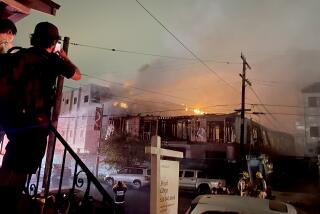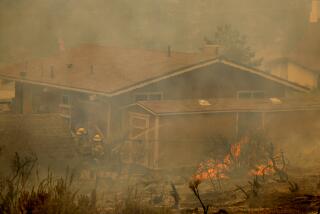Modest Proposal : Fire Victims ‘Need a Buddy’ Afterward
On the morning of June 28, 1990, a ranger came to my backpacking tent in Big Sur and asked if I was “the rabbi from Santa Barbara.” He told me, “Your family and your home are safe, but Santa Barbara is on fire.” My wife, remarkably, had tracked me down with the help of the rangers. While my synagogue miraculously escaped damage, I returned to see familiar neighborhoods reduced to ashes and to friends who had escaped with only the clothing on their backs.
Then, as now, there was an initial enormous outpouring of sympathy and help. But as the news moves on to other things, the sense of urgency fades--the temptation is to just let the government and relief organizations provide assistance. But now is the time when these fire victims need more help than ever: The adrenalin is gone, reality is sinking in and the drudgery of an uprooted life is taking hold.
After the Santa Barbara fire, a dedicated group of volunteers at Congregation B’nai B’rith created a highly effective outreach program that became a critical link for many whose lives had been shattered. Perhaps churches and volunteer organizations in the more recent fire zones can benefit from our experience.
Our most important activity was the creation of a “buddy system,” assigning one member of our congregation to each family in need. We began by serving the 18 of our member families who had lost their homes, then expanded to well over twice that number. The buddies were the conduit for information from and to the surviving family, determining with the family what needs they had (shelter, clothing, toys, furniture, transportation, child care and so on) and relating those needs to our central support coordinator. We developed a list of individuals willing to donate time, furniture, cookware, vans and other items (we were even able to find a complete set of “Star Wars” toys for a child who had lost this prized possession). We generated a list of apartments and homes for rent. A group of volunteers cooked homemade meals that families could pick up from the temple’s kitchen. The buddies became true lifelines and a source of incredible support.
We held regular community meals for the first few weeks so that survivors could share their stories and transmit vital information. At these meetings, we brought in various resource people--lawyers to review and explain insurance policies, insurance agents to discuss how best to work with adjusters, accountants to review records needed for tax purposes, an arborist to explain how to deal with burnt trees and plants and advise on what to plant to prevent erosion. Contractors came in to discuss the business of rebuilding. We created support information, such as a list of usual items in a kitchen and general belongings in a household, to help survivors in preparing the endless lists required by insurers. We created time-lines as reminders of the deadlines for government and insurance assistance.
We also reached out to a group that was being ignored. We called them the “burnt arounds”--those whose homes survived while all around them burned. Other activities included a meeting co-sponsored with the local school. The trauma of a fire affects everyone in a neighborhood, even those not directly hurt.
Many survivors were unable to save any possessions, including photos. Some innovative members of the temple located copies of commemorative photos by calling friends, sports leagues and schools. A member put together baskets, delivered on the Sabbath, that often included bread, a religious ritual object, flowers and a lot of love.
Even as I finish writing these words and look out my Santa Barbara window to the surrounding homes that were rebuilt and see the vegetation that has emerged, my heart still breaks for all those who lived through--and are living through--the nightmare of such loss.
While the government and the Red Cross are vital to the recovery process, so too are communities that are willing to create a support system. We all need a buddy sometimes.
More to Read
Sign up for Essential California
The most important California stories and recommendations in your inbox every morning.
You may occasionally receive promotional content from the Los Angeles Times.










